606 Search Results for visual support
July 8, 2012
by Carole Zangari -
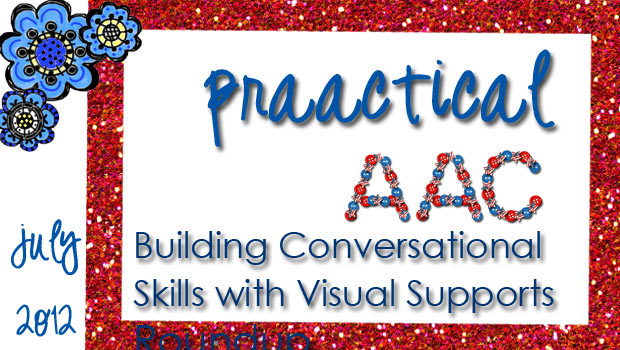
A young AAC user whom I know shared a story with me recently about feeling left out and struggling to find out why. Although she is smart, has age appropriate receptive language, and good command of her high tech SGD, building and maintaining friendships is a struggle. One of the things we’ll be doing to make changes in that area is to learn more about what makes a good conversation, adding vocabulary to make small talk easier, and practicing that. – Here’s a nice video, from Autism Teaching Strategies, that shows how to use visual supports and music to help learners remember to use some of the conversational continuers. Although Joel Shaul demonstrates this with visual supports that have words and phrases, the strategy works just as well with pictures for pre-literate communicators. – – Enjoy!
June 24, 2012
by Carole Zangari -
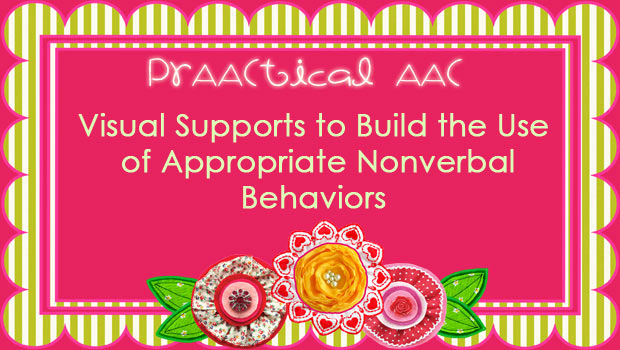
Most of our posts are about teaching language, but today we take a little side trip into nonverbal communication. We’ve all worked with folks who have difficulty maintaining appropriate distance and making eye contact, and know how problems in these area can really impede a person’s ability to relate well to others. Our video for this week, from Autism Teaching Strategies, illustrates how to use pictures supports to teach appropriate nonlinguistic conversational behaviors. – Of course, we were drawn to it because of our own experience that using pictures as a reminder is much easier to fade than oral language prompts (e.g., ‘Don’t forget to look at me when you talk;’ ‘Quiet hands’). – What we also love about this video is the teaching strategy: role reversal. In this strategy, the SLP (or teacher/parent) provides a model of both positive and negative examples of the target skill. The learner’s job... [Read More...]
June 5, 2012
by Robin Parker -
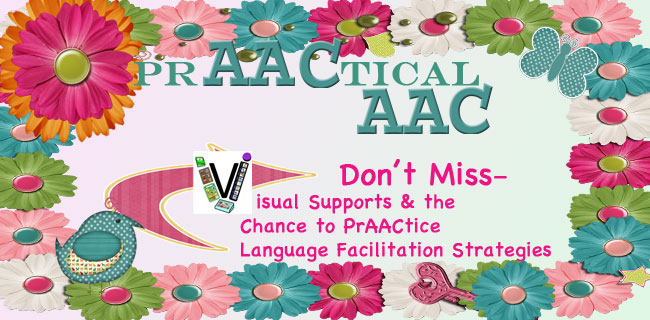
We have to commend and thank a classroom teacher who made it her priority to learn and share information about visual supports and communication. She developed a great wiki with many awesome visual support downloads. She worked with a mentor through the Florida Partnership for Effective Programs for Students with Autism (PEPSA). The mission of this great program is to enhance the education for students with autism spectrum disorders. With projects like this, the education of everyone is enhanced. The visual supports are for PrAACtical activities and learning. Find your favorite and then apply language facilitation strategies when teaching communication with the symbols. Check this out at: http://pkautismvisuals.wikispaces.com/Welcome Academic Supports Basic Communication Daily Routines Fun and Games
April 25, 2012
by Carole Zangari -
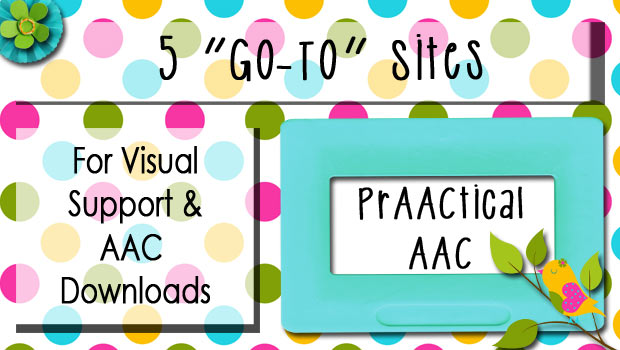
We’ve shared a number of resources for downloadable AAC materials in previous posts like this and on some of our Pinterest boards. Sometimes we start from scratch but other times we check out what other professionals and families have created, then download and adapt them for our use. It’s wonderful to see the generous online community growing! Here are some more sites we like for AAC and visual support downloads. – 1. For Visual Supports from Hamilton Boone Madison Special Services Cooperative 2. From Special Education Technology-British Columbia: PictureSet 3. Free software with symbols for making visual supports: QuickPics Symbols from Patrick Ecker 4. Behavioral supports from eLearning Visuals 5. Wonderful activities to support language and literacy from Dr. Caroline Musselwhite – Where do you go for online materials to download materials for your AAC work?
January 8, 2012
by Robin Parker -
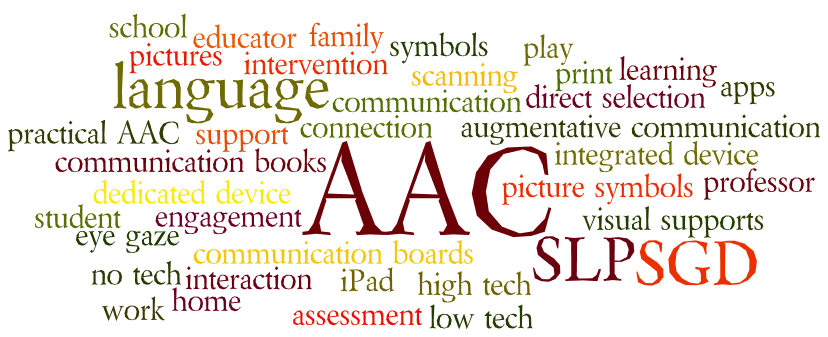
Resolution #2: Get the word out that USING visual supports can help improve behavior: 5 Visual Supports to Make it Easy (it’s more about what WE do – then compliance of the student) 1. Choice Boards 2. First- Then Board 3. Stop/Go Signs 4. Border Tape 5. Break Card
August 15, 2019
by Carole Zangari -
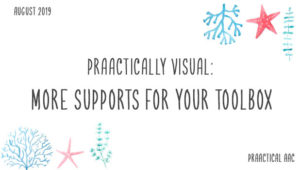
Visual supports are among the most helpful tools that AAC interventionists can use to maximize learning. Tabi Jones-Wohleber’s series on utilizing them in AAC work comes to an end today with a few more visual supports for your toolbox. Tabi is a veteran SLP who has supported individuals with AAC needs in a variety of practice settings. Many thanks to Tabi for this wonderful series and all of the free downloads that were included. You can access previous posts in the series here. Part 1: Visual & Environmental Countdown Part 2: Organizing Time & Tasks Part 3: Self-Regulation & Understanding Expectations Part 4: Supporting Communication Across Activities & Environments Part 5: Supports for When Modeling Communication is Hard ::::::::::::::::::::::::::::::::::::::::::::::::::::::::::::::::::::::::::::::::::::::::::::::::::::::::::::::::::::::::::::::::::::::::::::::::::: More Visual Supports for Your Toolbox I find there is no end to the rabbit-hole of visual supports, once you dive in. Tools and structures to support comprehension and learning are... [Read More...]
August 8, 2019
by Carole Zangari -

Have you run into situations where you know that aided language input is needed but found it really hard to implement? We’re pleased that AAC SLP Tabi Jones-Wohleber is back with another installment in her visual support series. In this post, she gives us suggestions for things to try when working out the nuances of aided language input. In case you missed them, here are the links to the previous posts in this series. Part 1: Visual & Environmental Countdown Part 2: Organizing Time & Tasks Part 3: Self-Regulation & Understanding Expectations Part 4: Supporting Communication Across Activities & Environments ::::::::::::::::::::::::::::::::::::::::::::::::::::::::::::::::::::::::::::::::::::::::::::::::::::::::::::::::::::::::::::::::::::::::::::::::::: Visual Supports for When Modeling Communication is Hard Despite our efforts, some of the time, or with some individuals, modeling AAC to teach AAC on technology-based devices can be challenging. An individual may be in constant motion, or possessive of their device. Tech-based devices may not be sufficiently durable... [Read More...]
August 1, 2019
by Carole Zangari -
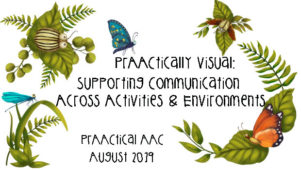
We’re thrilled to continue our series on visual supports, guest authored by AAC SLP Tabi Jones-Wohleber. Tabi has been an AAC service provider for many years and graciously offered to share some of her resources with our PrAACtical AAC readers. In today’s post, Tabi focuses on supplemental AAC supports that promote communication throughout the day. Be sure to download the files for the templates and resources she is sharing. In case you missed them, here are the links to the previous posts in this series. Part 1: Visual & Environmental Countdown Part 2: Organizing Time & Tasks Part 3: Self-Regulation & Understanding Expectations :::::::::::::::::::::::::::::::::::::::::::::::::::::::::::::::::::::::::::::::::::::::::::::::::::::::::::::::::::::::::::::::::::::::::::::::::::::::::::::::::::: PrAACtically Visual: Visual Supports for Communication Across Activities and Environments As the near entirety of this site is dedicated to resources for AAC implementation and access for individuals with complex communication needs, I’m not going to attempt to summarize here, as I have with the other... [Read More...]
July 25, 2019
by Carole Zangari -

Looking to up your game in creating and using visual supports in your AAC work? Sit tight because the post below has plenty of information and downloadable files to help you out. Today, AAC SLP Tabi Jones-Wohleber is back to continue her series, this time focusing on supports for self-regulation and comprehending expectations for different situations. Tabi has worked in schools and early intervention supporting families, professionals, and individuals with AAC needs in West Virginia and Maryland. Tabi’s prAACtical approach to supporting AAC professionals has enriched the work of many of our readers. If you missed the initial segments in the series, you can get those here. Part 1 Part 2 Visual and Environmental Supports for Self-regulation & Understanding Expectations I hold the position that all behavior is communication. Attending to what an individual is attempting to communicate through behavior provides insight into why the behavior is occurring. And to... [Read More...]
July 18, 2019
by Carole Zangari -
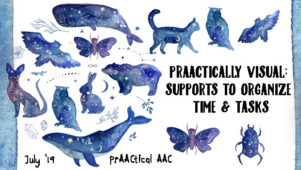
We’re glad you’ve returned for Part 2 of Tabi Jones-Wohleber’s series on Visual Supports. As an AAC specialist, Tabi uses these with children who have complex communication needs and teaches others to incorporate them as well. Let’s learn some of the ways in which visual supports can be used to help with organization, transitions, and independence. You can click on the images in the Downloadable Templates section to obtain the visual support files. If you’re interested in seeing more of Tabi’s work, you can check out Part 1 of the series here. ::::::::::::::::::::::::::::::::::::::::::::::::::::::::::::::::::::::::::::::::::::::::::: Visual and Environmental Supports to Organize Time and Tasks “But he knows his schedule” isn’t the whole picture. We all use schedules to help us manage our time and keep us on track when non-routine activities occur. For instance, you may know your schedule for any given Tuesday, but what about that Tuesday when you have... [Read More...]









